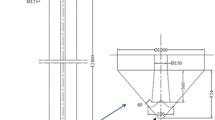Abstract
This paper focuses on providing a pervaporation simulation method for ethanol dehydration from a practical point of view. The simulation procedure is performed by setting up simulation equations which describe the pervaporation process, obtaining the necessary data from pervaporation batch mode pilot tests, verifying the simulation tool through simulations of continuous mode pilot tests, and comparing the simulation results with the real pilot test results. We considered the mass and energy balances that describe separating an ethanol/water mixture by a pervaporation membrane. The simulation equations were mathematically expressed into simultaneous non-linear differential equations based on these balances. The necessary data for simulation consist of the thermophysical properties for the ethanol-water mixture and the characteristic data of a PVA composite membrane. The membrane characteristic data are permeation flux and membrane selectivity, which are functions of feed composition and operating conditions. These data were experimentally determined by a batch mode pilot test. The continuous mode pilot tests were simulated and the simulation results were compared to the real test results. The resulte were fairly good.
Similar content being viewed by others
References
Aptel, P., Challard, N., Cuny, J. and Neel, J., “Application of the Pervaporation Process to Separate Azeotropic Mixtures”,J. Memb. Sci.,1, 271 (1976).
Binning, R. C., Lee, R. J., Jennings, J. F. and Martin, E. C., “Separation of Liquid Mixtures by Permeation ”,Ind. Eng. Chem.,53, 45 (1961).
Black, C., “Distillation Modeling of Ethanol Recovery and Dehydration Processes for Ethanol and Gasohol”,Chem. Eng. Progr.,September,78 (1980).
Chang, J.-H., Yoo, J.-K., Ahn, S.-H., Lee, K.-H. and Yoo, K.-O., “Development of Pervaporation System Simulator”,Membrane J. (Korean),7(1), 31 (1997).
Daubert, D. E. and Danner, R. P., “Physical and Thermodynamic Properties of Pure Chemicals: Data Compilation, Design Institute for Physical Property Data”, AIChE., Hemisphere Publishing Corporation (1991).
Fleming, H. L., “Consider Membrane Pervaporation “,Chem. Eng. Progr.,July, 46 (1992).
Fleming, H. L. and Slater, C. S., “Chapter 10. Pervaporation: Applications and Economics ”, Membrane Handbook, Ho, W. S. W. and Sirkar, K. K., eds., Van Nostrand Reinhold, New York (1992).
Gmehling, J. and Onken, U., “Vapor-liquid Equilibrium Data Collection, Aqueous-organic Systems”, Dechema Chemistry Data Series, Vol. 1, Part 1, DECHEMA, Frankfurt am Main, Germany (1977).
Huang, R. Y. M. and Jarvis, N. R., “Separation of Liquid Mixtures by Using Polymer Membranes, II. Permeation of Aqueous Alcohol Solutions through Cellophane and Poly(vinylalcohol)”,J. Appl Poiym. Sci,14, 2341 (1970).
Humphrey, J. L. and Seibert, A. F., “Separation Technologies: An Opportunity for Energy Savings “,Chem. Eng. Progr.,March, 32 (1992).
Marin, M., Kalantzi, K. and Gilbert, H., “Pervaporation Process: Membrane Conditioning and Experimental Mass Transfer Analysis”,J. Memb. Sci,74, 105 (1992).
Mulder, M. H. V. and Smolder, C. A., “On the Mechanism of Separation of Ethanol/Water Mixtures by Pervaporation. I. Calculation of Concentration Profiles “,J. Memb. Sci,17, 289 (1984).
Mulder, M. H. V., Franken, A. C. M. and Smolder, C.A., “On the Mechanism of Separation of Ethanol/Water Mixtures by Pervaporation. II. Experimental Concentration Profiles”,J. Memb. Sci.,23, 41 (1985).
Nguyen, T. Q., “The Influence of Operating Parameters on the Performance of Pervaporation Processes”,AIChE Symposium Series,82(248), 1 (1986).
Rapin, J. L., “The Betheniville Pervaporation Unit-The First Large Scale Production Plant for the Dehydration of Ethanol”, Proceedings of Third International Conference on Pervaporation Processes in the Chemical Industry, Englewood, NJ, 364 (1988).
Rautenbach, R. and Albrecht, R., “The Separation Potential of Pervaporation, part 1: Discussion of Transport Equations and Comparison with Reverse Osmosis ”,J. Memb. Sci.,25, 1 (1985a).
Rautenbach, R. and Albrecht, R., “The Separation Potential of Pervaporation, part 2: Process Design and Economics”,J. Memb. Sci.,25, 25 (1985b).
Streicher, C., Kremer, P., Tomas, V., Hubner, A. and Ellinghorst, G., “Development of New Pervaporation Membranes, Systems and Processes to Separate Alcohols/Ethers/ Hydrocarbons Mixtures”, Proceedings of Seven International Conference on Pervaporation Processes in the Chemical Industry, Reno, Nevada, 297 (1995).
Tusel, G. F. and Bruschke, H. E. A., “Use of Pervaporation Systems in the Chemical Industry”,Desalination,53, 327 (1985).
Wijmans, J. G. and Baker, R. W., “A Simple Predictive Treatment of the Permeation Process in Pervaporation”,79, 101 (1993).
Yeom, C.-K., Dickson, J. M. and Brook, M. A., “A Characterization of PDMS Pervaporation Membranes for the Removal of Trace Organic from Water”,Korean J. Chetn. Eng.,13(5), 482 (1996).
Author information
Authors and Affiliations
Corresponding author
Rights and permissions
About this article
Cite this article
Chang, JH., Yoo, JK., Ahn, SH. et al. Simulation of pervaporation process for ethanol dehydration by using pilot test results. Korean J. Chem. Eng. 15, 28–36 (1998). https://doi.org/10.1007/BF02705302
Received:
Accepted:
Issue Date:
DOI: https://doi.org/10.1007/BF02705302




